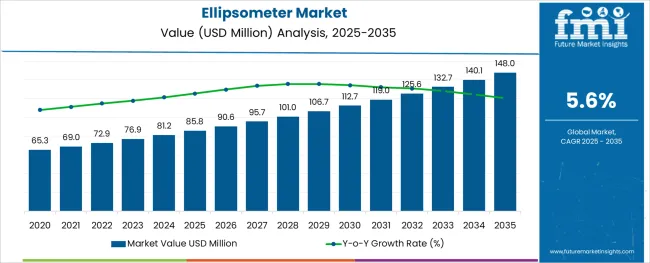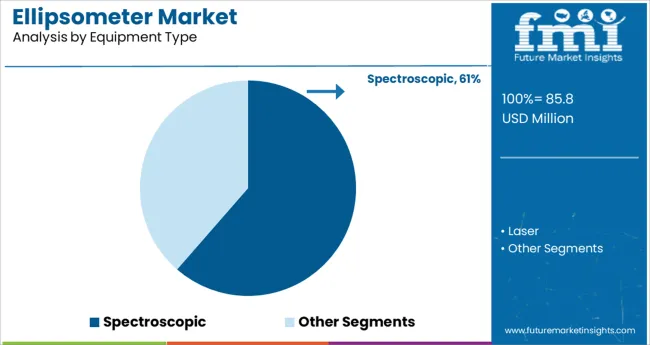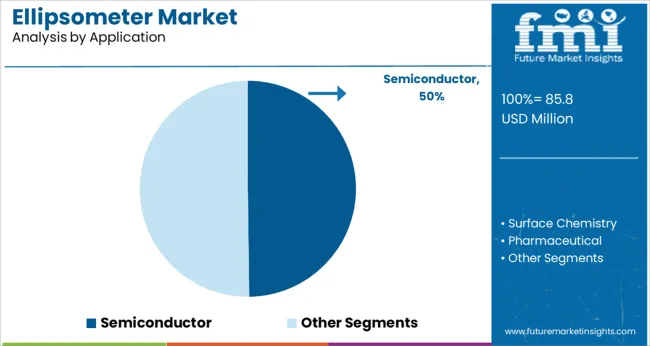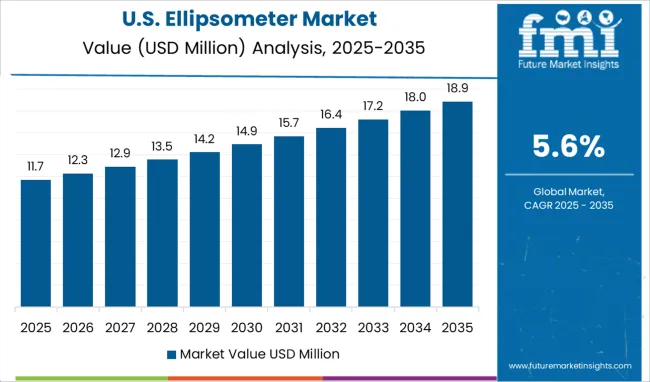The Ellipsometer Market is estimated to be valued at USD 85.8 million in 2025 and is projected to reach USD 148.0 million by 2035, registering a compound annual growth rate (CAGR) of 5.6% over the forecast period.

The ellipsometer market is expanding steadily, fueled by advancements in thin film measurement technologies and the increasing demand for precise material characterization. The growth of semiconductor manufacturing and research has been a significant driver, as ellipsometers play a critical role in monitoring film thickness, refractive index, and optical properties essential for device fabrication.
Industry experts highlight the importance of high-resolution and non-destructive measurement techniques, making ellipsometers indispensable tools in process control and quality assurance. The adoption of spectroscopic ellipsometers has increased due to their ability to analyze a wide spectral range and provide detailed information about complex multilayer structures.
Additionally, the growing use of ellipsometry in emerging applications such as photovoltaics, OLEDs, and biomedical devices has broadened the market. Future growth is expected to continue alongside semiconductor industry expansion and the development of next-generation materials and devices. Segmental demand is anticipated to be led by the Spectroscopic equipment type and Semiconductor application segments, driven by their critical roles in precision manufacturing and research.
The market is segmented by Equipment Type and Application and region. By Equipment Type, the market is divided into Spectroscopic and Laser. In terms of Application, the market is classified into Semiconductor, Surface Chemistry, Pharmaceutical, Biotechnology, and Others. Regionally, the market is classified into North America, Latin America, Western Europe, Eastern Europe, Balkan & Baltic Countries, Russia & Belarus, Central Asia, East Asia, South Asia & Pacific, and the Middle East & Africa.
The market is segmented by Equipment Type and Application and region. By Equipment Type, the market is divided into Spectroscopic and Laser. In terms of Application, the market is classified into Semiconductor, Surface Chemistry, Pharmaceutical, Biotechnology, and Others. Regionally, the market is classified into North America, Latin America, Western Europe, Eastern Europe, Balkan & Baltic Countries, Russia & Belarus, Central Asia, East Asia, South Asia & Pacific, and the Middle East & Africa.

The Spectroscopic ellipsometer segment is projected to account for 61.4% of the market revenue in 2025, establishing itself as the leading equipment type. Its growth is driven by the capability to measure over a broad wavelength range, providing detailed insights into film thickness and optical constants.
Spectroscopic ellipsometry allows for comprehensive analysis of complex materials including multilayers and nanostructures, making it highly valuable for advanced semiconductor manufacturing and research. This equipment type offers high accuracy, non-destructive testing, and compatibility with various sample types, which has expanded its adoption across industries.
The demand for real-time process monitoring and enhanced material characterization has further propelled the use of spectroscopic ellipsometers. As material science and device complexity evolve, the spectroscopic segment is expected to maintain its dominance in the ellipsometer market.

The Semiconductor application segment is expected to hold 49.8% of the ellipsometer market revenue in 2025, continuing to be the largest application area. Ellipsometers are critical in semiconductor fabrication for monitoring thin film deposition, etching, and surface treatment processes.
The semiconductor industry's drive toward miniaturization and higher device performance demands precise and repeatable thin film measurements, which ellipsometers deliver effectively. The rise of advanced semiconductor materials such as high-k dielectrics and 2D materials has increased reliance on ellipsometry for quality control.
Additionally, semiconductor research and development activities consistently require detailed optical characterization, supporting steady demand. With continuous innovation in semiconductor technology and the expansion of fabrication facilities worldwide, the semiconductor segment is expected to sustain its leadership position in the ellipsometer market.
One of the primary factors driving the ellipsometer industry is the machine's ability to measure the refractive index and width of thin transparent films to the smallest conceivable unit, such as 1nm. This factor has given ellipsometers a unique place in the global market.
The expanding popularity of ellipsometry, a method used to perform optical measurements, is eventually boosting demand for an ellipsometer. Another factor driving the growth of the ellipsometer market is the increasing requirement for optical measurement in sectors of development and manufacturing due to its non-invasive nature.
Users can tailor the size of the ellipsometer to their needs by changing characteristics such as the status of points, the reflectance of a tube, the number of points, and so on. Due to their distinctive characteristics such as fast examination speed, compact size, lightweight, and others, ellipsometry is becoming more popular in industrial applications.
Furthermore, ellipsometers are increasingly being used by thin-film analytical labs and also researchers in fields such as biology and medicine. This is projected to drive the Ellipsometer market.
The very first difficulty concerns the time-continuous real-time capture of ellipsometric spectra in milliseconds, which gives a high signal-to-noise ratio. Despite the fact that the use of a single-wavelength ellipsometer has already achieved picosecond resolution, spectral information would normally enhance the physical performance of ellipsometric data gathered during deposition or etch processes, particularly during the beginning stage.
The temperature-dependent optical material properties of various insulators, semiconductors, and metals were addressed in a second issue. These temperature-dependent factors would make it easier to translate ellipsometric spectra collected during deposition or etch procedures at a certain temperature into one-dimensional film attributes (such as layer thickness, surface roughness, or electrical conductivity). However, the high cost associated with the ellipsometer may limit the Ellipsometer market's growth.

Due to technical improvements and the high acceptance rate of ellipsometers in several fields such as semiconductors and electronics, academics and labs, photovoltaics, and solar cells, North America is expected to be the highest region internationally.
Furthermore, there have been considerable advancements in the material research areas, necessitating flexible and efficient materials analysis in this area. It necessitates the use of modern instrumentation methods to conduct the needed material study. This element is said to enhance North American market expansion and new ellipsometer market prospects.
In the United States, there has been an increase in the use of Ellipsometers by thin film analytical labs and researchers from other sectors such as biology and medicine. It is projected to drive the Ellipsometer market in North America. The expanding semiconductor sector, as well as the growing popularity of the ellipsometry approach, are expected to drive market expansion in this region in the coming years
According to the analysis, the expanding militarization of the semiconductor sector in the APAC region, particularly in developing economies, is likely to be the key driver of the ellipsometer market's growth. Furthermore, substantial breakthroughs in material research domains necessitate efficient, adaptable material analysis will bolster the market during the forecast period. To conduct the desired material study, modern instrumentation methods are required. This element is said to enhance the ellipsometer market's growth in this region in the coming years.

Film Sense, HORIBA, Falex Corporation, Optosense, J.A. Woollam Co., Gaertner Scientific Corporation, Accurian GmBH, SENTECH Instruments GmbH, Angstrom Sun Technologies Inc., Semilab, and others are among the top players of ellipsometers market. These prominent ellipsometer manufacturers are constantly conducting research and development to increase the accuracy and application areas of ellipsometry.
| Report Attribute | Details |
|---|---|
| Growth Rate | 5.6% CAGR from 2025 to 2035 |
| Market Value in 2025 | USD 72.86 Million |
| Market Value in 2035 | USD 125.65 Million |
| Base Year for Estimation | 2024 |
| Historical Data | 2020 to 2024 |
| Forecast Period | 2025 to 2035 |
| Quantitative Units | million for Value |
| Report Coverage | Revenue Forecast, Volume Forecast, Company Ranking, Competitive Landscape, Growth Factors, Trends, and Pricing Analysis |
| Segments Covered | Equipment Type, Application, Region |
| Regions Covered | North America; Latin America; Europe; Asia Pacific; CIS & Russia; Middle East & Africa |
| Key Countries Profiled | USA, Canada, Mexico, Brazil, Argentina, Peru, Chile, Rest of LATAM, Germany, Italy, UK, Spain, France, Nordic countries, BENELUX, Eastern Europe, Rest of Europe, Greater China, India, South Korea, ASEAN Countries, Rest of APEJ, GCC Countries, Turkey, Iran, Israel, S. Africa, Rest of MEA |
| Key Companies Profiled | Film Sense; HORIBA; Falex Corporation; Optosense; J.A. Woollam Co.; Gaertner scientific corporation; Accurian GmBH; SENTECH Instruments GmbH; Angstrom Sun Technologies Inc.; Semilab |
The global ellipsometer market is estimated to be valued at USD 85.8 million in 2025.
It is projected to reach USD 148.0 million by 2035.
The market is expected to grow at a 5.6% CAGR between 2025 and 2035.
The key product types are spectroscopic and laser.
semiconductor segment is expected to dominate with a 49.8% industry share in 2025.






Full Research Suite comprises of:
Market outlook & trends analysis
Interviews & case studies
Strategic recommendations
Vendor profiles & capabilities analysis
5-year forecasts
8 regions and 60+ country-level data splits
Market segment data splits
12 months of continuous data updates
DELIVERED AS:
PDF EXCEL ONLINE

Thank you!
You will receive an email from our Business Development Manager. Please be sure to check your SPAM/JUNK folder too.
Chat With
MaRIA